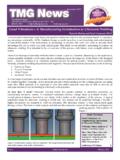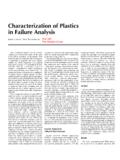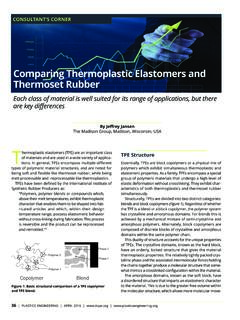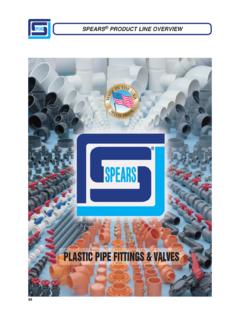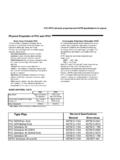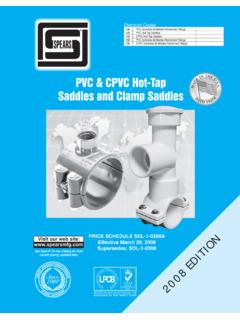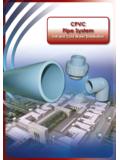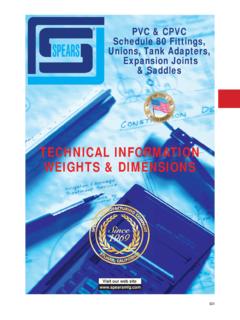Transcription of A Study of the Freezing Phenomena in PVC and …
1 A Study of the Freezing Phenomena in PVC and cpvc pipe Systems Javier Cruz, Bruce Davis, Paul Gramann, Antoine Rios The Madison Group Madison, WI 53711 Abstract Residential and commercial piping systems often experience complex failures from freeze events. In this paper the Freezing failures are studied by replicating pipe Freezing conditions in a laboratory setting. Testing was performed on inch ( ) PVC and cpvc pipes. Pressure and temperature during the freeze event were monitored and the fracture modes of failed pipes were examined.
2 Freeze events result in excessively high pressures. It has been shown that during a freeze event, the properties of plastic pipes are advantageous over other more rigid piping systems. In this Study , it was observed that PVC and cpvc pipes were able to sustain over thirty times the typical household water pressure before bursting occurred. Introduction Chlorinated poly(vinyl chloride) ( cpvc ) and poly(vinyl chloride) (PVC) pipes are two of the most commonly used materials for piping systems. Plastic is a popular alternative to steel piping due to lower cost and easier installation.
3 Plastic piping can also reduce noise by as much as four times over copper of comparable size. There are also fewer problems associated with condensation and corrosion of plastic pipes. Additionally, there is a significant difference between mechanical and thermal properties of metal and plastic pipes. During a high-pressure event, a plastic pipe will expand to absorb increases in pressure such as those found in a freeze event. Plastic pipes also have thicker walls and greater thermal resistance than metal pipes. For comparison, the thermal conductivity (k) of PVC pipe is kW/m-K while for copper it is kW/m-K.
4 The high conductivity of copper corresponds to a thermal resistance that is basically negligible [1]. Copper pipes will in turn cool faster when exposed to lower temperatures resulting in an earlier freeze event. Nevertheless, plastic pipe Freezing failures are a problem commonly experienced in residential and commercial buildings. These failures are primarily attributed to improper pipe /building insulation and controlled interior temperatures. The problem is greater in the southern states where warmer winters are more common and some builders/plumbers use inadequate insulation to protect pipes from occasional sub- Freezing temperatures [2].
5 Ice Formation in a Piping System As water undergoes a phase transition from liquid to solid the density decreases. The orientation of molecules in ice results in a structure that occupies more volume than liquid water. According to the phase transition into ice, as water freezes a net expansion in volume of approximately 9% occurs. This net expansion in volume ultimately causes the bursting of plastic pipes. However, failure often occurs at a remote section of pipe through an indirect mechanism generated by the actual phase change expansion at the freeze point.
6 A freeze event in a plastic water piping system is a complex phenomenon. PVC and cpvc pipe filled with water, sealed and placed in a Freezing environment typically will not crack. The pipes will expand to absorb the net volumetric expansion of ice. Since the volume in a pipe is proportional to the square of the diameter, a 9% volumetric expansion will result in a net diameter expansion of approximately 3%. Performing a linear elastic mechanical analysis for a thin-walled closed cylinder results in hoop and axial strain values of and , respectively [3].
7 Both PVC and cpvc have the ability to expand and withstand the resulting pressure generated by this change in volume. However, if localized Freezing in a water piping system occurs and results in the formation of an ice plug the system will become closed. Any additional Freezing that occurs downstream of the plug will create a pressure rise in the system. As ice continues to form, the pressure in the remaining water will rise until the plastic pipe fails. Freezing of water in a pipe occurs in different stages. Figure 1 shows a schematic that describes the different stages of Freezing .
8 Initially, the pipe is exposed to a subfreezing temperature and the heat transfers from the water through the pipe wall and any insulation layers. This will reduce the temperature of the water. The water temperature can fall below the phase change temperature of 0 C and reach a supercooling stage without ice formation [1, 4, 5]. This supercooling stage can last for extensive periods of time and reach temperatures significantly below the phase change temperature. At some point during the supercooling stage, the water will initiate ice nucleation.
9 At this moment, ice crystals in the dendritic form will immediately begin to grow. The dendritic ice formation is a quick event that ends when the water stabilizes at the phase change temperature. A solid ice structure then grows inward. The temperature during this period remains constant until all the water in the region has frozen. Because the dendritic ice nucleates on the walls of the pipe and grows inward it results in a strong plug that can withstand extremely high pressures. For a closed piping system further ice formation results in an extreme pressure rise that can generate failure.
10 In some occasions variation in the growth of dendritic ice against the wall combined with the high downstream pressure may cause the plug to slide back lowering the system pressure. Experimental Based on the knowledge that bursting of water pipes does not occur directly from the physical pressure applied by the growing ice but by the excessive water pressure generated from ice formation, an experimental setup was developed where a pipe could be exposed to subfreezing temperatures to cause an adjacent pipe to fail. Figure 2 shows a schematic of the setup.
